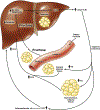Sugar, Sugar . . . Not So Sweet for the Liver
- PMID: 28757270
- PMCID: PMC9137372
- DOI: 10.1053/j.gastro.2017.07.029
Sugar, Sugar . . . Not So Sweet for the Liver
Figures

Comment on
-
Effects of Dietary Fructose Restriction on Liver Fat, De Novo Lipogenesis, and Insulin Kinetics in Children With Obesity.Gastroenterology. 2017 Sep;153(3):743-752. doi: 10.1053/j.gastro.2017.05.043. Epub 2017 Jun 1. Gastroenterology. 2017. PMID: 28579536 Free PMC article.
References
-
- Vos MB, Abrams SH, Barlow SE, et al. NASPGHAN clinical practice guideline for the diagnosis and treatment of nonalcoholic fatty liver disease in children: recommendations from the Expert Committee on NAFLD (ECON) and the North American Society of Pediatric Gastroenterology, Hepatology and Nutrition (NASPGHAN). J Pediatr Gastroenterol Nutr 2017;64:319–334. - PMC - PubMed
Publication types
MeSH terms
Substances
Grants and funding
LinkOut - more resources
Full Text Sources
Other Literature Sources

